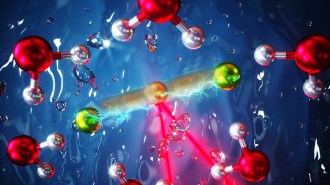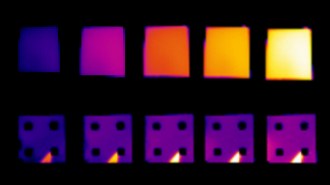Search Results
Sizing up alien rain
Students will answer questions about the online Science News article “How the laws of physics constrain the size of alien raindrops,” which explores a new model for rain on planets across the Milky Way. A version of the story, “Physics helps alien rain stay in shape,” appears in the May 8, 2021 & May 22, 2021 issue of Science News.
Modeling molecules in alien rain
Students will compare and contrast rain on Earth with rain on other planets and practice drawing molecular structures of various rain substances to examine the substances' physical and chemical properties. Students will use that information, along with the planetary conditions needed to form rain, to create a short weather forecast for one planet.
Building better boxes based on beetles
In this activity, students will learn about the seemingly indestructible diabolical ironclad beetle and review Newton’s laws of motion and force diagrams. Then, students will design, build and test crush-resistant packaging using biomimetics, the practice of solving problems using solutions inspired by biological structures and systems.

Chemical Bond Acts Like a Mash-Up
In this guide, students will learn about recent research findings that challenge long-held ideas about chemical bonding and discuss how to incorporate exceptions to general chemistry concepts into their learning.
Accepting the exceptions
Students will discuss the classical definitions of chemical bonds and determine how to adjust those definitions based on new research. Then, students will talk about the best strategies for assessing general chemistry concepts and exceptions to those generalizations.
The joy of science
Students will answer questions about the online Science News article “From Elvis worms to the Milky Way’s edge, these science stories sparked joy in 2020,” which summarizes Science News stories from 2020 that provided a happy distraction from the world’s worries. A version of the story, “Stories that sparked joy,” can be found in the December 19, 2020 & January 2, 2021 issue of Science News.
Colorful chemistry
Students will review concepts of light and chemical structures to explore color. Then, students will partner up to research a pigment of their choice and present their findings to the class.

Concussion Leaves Clues in the Blood
This guide asks students to explore research into concussions and draw on their own experiences to think about the various signs and symptoms of injury or disease. After testing various materials, students will develop designs for protective headgear.
Protective headgear design challenge
Concussions are a common sports injury. After reviewing Newton’s laws of motion, force diagrams, momentum, and elastic and inelastic collisions, students will test various materials that might protect the head from sports collisions and use those materials to design protective headgear.

Coating Provides Infrared Camouflage
This guide, based on the Science News article “Coating provides infrared camouflage,” asks students to explore the physics and potential technological applications of a material, discuss the various types of electromagnetic radiation, analyze infrared images and research how infrared imaging is used across a range of fields.
Seeing in infrared
In this activity, students will analyze infrared images and then explore how infrared imaging is used across a range of fields of work. Skills include researching, evaluating, synthesizing and presenting information.
Exploring electromagnetic radiation
Students will watch a NASA video about the electromagnetic spectrum to learn about properties of the various types of radiation. Then, students will explore and discuss technologies that use specific types of electromagnetic radiation.